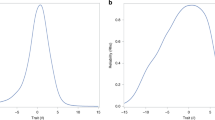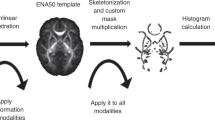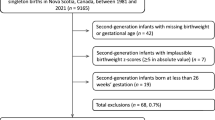Abstract
Background
Analysis of developmental trajectories is crucial to understand how and when neurodevelopmental vulnerability contributes to social, communication, and cognitive impairments. We report on an online, longitudinal caregiver-report tool that characterizes the growth trajectories of social communication cognition (SCG) abilities in infants/toddlers born term or preterm.
Methods
Longitudinal item response theory modeling was used to estimate item parameters of caregiver ratings on the SCG domain of PediaTracTM in a sample of 571 neonates (331 term, 240 preterm) from the newborn period to 18 months. Moderating effects of sex was examined. It was hypothesized: 1) trajectories of the latent trait SCG could be estimated by gamma1 (slope) with alpha discrimination in the high range; and 2) term status differences in gamma1 could be demonstrated over 18 months.
Results
The longitudinal SCG trajectory was estimated with high discrimination (α = 1.48). Preterm infants exhibited a slower rate of SCG growth (gamma1 p < 0.0001), detectable by 9 months of age (longitudinal theta p = 0.02). Females exhibited more rapid SCG growth.
Conclusion
The SCG items of PediaTrac are highly informative across the first 18 months. Growth trajectories in social communication cognition development may be an important indicator of neurodevelopmental risk and treatment effects.
Impact
-
This is the first caregiver report instrument that can characterize the longitudinal growth trajectory of social communication cognition development over infancy/toddlerhood.
-
The longitudinal trajectory for the caregiver reported social communication cognition (SCG) domain of PediaTrac could reliably discriminate infants/toddlers at different levels of ability by term and preterm status.
-
Significant term status differences in development could be detected by 9 months of age.
-
Biological sex differences in social communication cognition development were detected by 12 months of age.
-
Including caregivers in digital reporting and child-centered monitoring of social communication cognition development over time may improve access to care.
This is a preview of subscription content, access via your institution
Access options
Subscribe to this journal
Receive 14 print issues and online access
$259.00 per year
only $18.50 per issue
Buy this article
- Purchase on SpringerLink
- Instant access to full article PDF
Prices may be subject to local taxes which are calculated during checkout


Similar content being viewed by others
Data availability
Selected raw data of this investigation will be made available to the National Database for Autism Research at the completion of this project. The computer code, syntax, and/or analysis code on which the study results are derived are not yet available. The datasets generated during and/or analyzed during the current study are not publicly available yet as this is a longitudinal investigation that is still underway. Upon completion of the longitudinal investigation, the datasets generated during this study will be deposited into the National Database for Autism Research (NDAR).
References
Cree, R. A. et al. Morbidity and Mortality Weekly Report. Health Care, Family, and Community Factors Associated with Mental, Behavioral, and Developmental Disorders and Poverty Among Children Aged 2-8 Years-United States, 2016. https://www.cdc.gov/mmwr/cme/conted_info.html#weekly (CDC, 2016).
Casey, B. J., Oliveri, M. E. & Insel, T. A neurodevelopmental perspective on the research domain criteria (RDoC) framework. Biol. Psychiatry 76, 350–353 (2014).
Luby, J. et al. Mapping infant neurodevelopmental precursors of mental disorders: how synthetic cohorts & computational approaches can be used to enhance prediction of early childhood psychopathology. Behav. Res. Ther. 123, https://doi.org/10.1016/j.brat.2019.103484 (2019).
Mittal, V. A. & Wakschlag, L. S. Research domain criteria (RDoC) grows up: strengthening neurodevelopment investigation within the RDoC framework. J. Affect. Disord. 216, 30–35 (2017).
Speranza, A. M., Liotti, M., Spoletini, I., Fortunato, A. Heterotypic and homotypic continuity in psychopathology: a narrative review. Front. Psychol. 14, https://doi.org/10.3389/fpsyg.2023.1194249 (2023).
Rautakoski, P. et al. Communication skills predict social-emotional competencies. J. Commun. Disord. 93, 106138 (2021).
Iverson, J. M. Developmental variability and developmental cascades: lessons from motor and language development in infancy. Curr. Dir. Psychol. Sci. 30, 228–235 (2021).
Lung, F. W., Shu, B. C., Chiang, T. L. & Lin, S. J. Measurement of social communication, emotion and cognitive development from 6 months to 8 years old: in a Taiwan birth cohort study. Child Psychiatry Hum. Dev. 51, 868–875 (2020).
DeGangi, G. Pediatric Disorders of Regulation in Affect and Behavior. https://doi.org/10.1016/B978-0-12-208770-7.X5000-6 (Academic Press, 2000).
Toseeb, U., Oginni, O. A. & Dale, P. S. Developmental language disorder and psychopathology: disentangling shared genetic and environmental influences. J. Learn Disabil. 55, 185–199 (2022).
Amgalan, A., Andescavage, N. & Limperopoulos, C. Prenatal origins of neuropsychiatric diseases. Acta Paediatr.110, 1741–1749 (2021).
Athanasiadou, A. et al. Early motor signs of attention-deficit hyperactivity disorder: a systematic review. Eur. Child Adolesc. Psychiatry 29, 903–916 (2020).
Adlof, S. M. & Hogan, T. P. Understanding dyslexia in the context of developmental language disorders. Lang. Speech Hear Serv. Sch. 49, 762–773 (2018).
Franz, A. P. et al. Development of a risk calculator to predict attention-deficit/hyperactivity disorder in very preterm/very low birth weight newborns. J. Child Psychol. Psychiatry 63, 929–938 (2022).
Cherkasova, M. V. et al. Adult outcome as seen through controlled prospective follow-up studies of children with attention-deficit/hyperactivity disorder followed into adulthood. J. Am. Acad. Child Adolesc. Psychiatry 61, 378–391 https://www.jaacap.org (2022).
Labor Rand. Proven Benefits of Early Childhood Interventions. www.rand.org (2005).
Nectac. The importance of early intervention for infants and toddlers with disabilities and their families. https://doi.org/10.1111/j.1469 (2011).
Nores, M. & Barnett, W. S. Benefits of early childhood interventions across the world: (under) Investing in the very young. Econ. Educ. Rev. 29, 271–282 (2010).
Orton, J., Spittle, A., Doyle, L., Anderson, P. & Boyd, R. Do early intervention programmes improve cognitive and motor outcomes for preterm infants after discharge? A systematic review. Dev. Med. Child Neurol. 51, 851–859 (2009).
Holmbeck, G. N., Bruno, E. F. & Jandasek, B. Longitudinal research in pediatric psychology: an introduction to the special issue. J. Pediatr. Psychol. 31, 995–1001 (2006).
Li, S. J. et al. Cognitive and motor development in preterm children from 6 to 36 months of age: trajectories, risk factors and predictability. Early Hum. Dev. 172. https://doi.org/10.1016/j.earlhumdev.2022.105634 (2022)
Nishimura, T., Takei, N., Tsuchiya, K. J. Neurodevelopmental trajectory during infancy and diagnosis of autism spectrum disorder as an outcome at 32 months of age. Epidemiology 30, S9–S14. https://doi.org/10.1097/EDE.0000000000000996 (2019).
Durrant, C. et al. Developmental trajectories of infants born at less than 30 weeks’ gestation on the Bayley-III Scales. Arch. Dis. Child Fetal Neonatal Ed. 105, 623–627 (2020).
Neel, M. L. et al. Bayley trajectories predict school readiness better than single assessments in formerly very preterm preschoolers. Pediatr. Res. 94, 1392–1399 (2023).
Cai, L., Choi, K., Hansen, M. & Harrell, L. Item response theory. Annu. Rev. Stat. Appl. 3, 297–321 (2016).
Embretson, S. E., Reise, SP. Item Response Theory for Psychologists (Erlbaum, 2000).
Hambleton, R. K., Swaminathan, H., Jane Rogers, H. Fundamentals of Item Response Theory (Sage Publications, Inc., 1991).
Gorter, R. et al. Latent growth modeling of IRT versus CTT measured longitudinal latent variables. Stat. Methods Med Res 29, 962–986 (2020).
Chronis-Tuscano, A. et al. Stable early maternal report of behavioral inhibition predicts lifetime social anxiety disorder in adolescence. J. Am. Acad. Child Adolesc. Psychiatry 48, 928–935 (2009).
Ozonoff, S. et al. Diagnostic stability in young children at risk for autism spectrum disorder: a baby siblings research consortium study. J. Child Psychol. Psychiatry 56, 988–998 (2015).
Lajiness-O’Neill, R. et al. Development and validation of PediaTracTM: a web-based tool to track developing infants. Infant Behav. Dev. 50, 224–237 (2018).
Lajiness-O’Neill, R. et al. PediaTrac V.3.0 protocol: a prospective, longitudinal study of the development and validation of a web-based tool to measure and track infant and toddler development from birth through 18 months. BMJ Open 11, e050488 (2021).
King, L. S., Querdasi, F. R., Humphreys, K. L., Gotlib, I. H. Dimensions of the language environment in infancy and symptoms of psychopathology in toddlerhood. Dev. Sci. 24. https://doi.org/10.1111/desc.13082 (2021).
Nishimura, T. et al. Sex differences in neurodevelopmental trajectories in children with different levels of autistic traits. https://doi.org/10.1111/pcn.13529/full (2023).
Kertesz-Briest, H. A. et al. Examining relations between neuropsychological and clinical epilepsy-specific factors with psychopathology and adaptive skills outcomes in youth with intractable epilepsy. Epilepsy Behav. 110. https://doi.org/10.1016/j.yebeh.2020.107171 (2020).
Ji, W. et al. Preterm birth associated alterations in brain structure, cognitive functioning and behavior in children from the ABCD dataset. Psychol. Med. 54, 409–418 (2024).
Roizen, N. J. et al. 22q11.2DS deletion syndrome: developmental milestones in infants and toddlers. J. Dev. Behav. Pediatr. 28, 119–125 (2007).
Armando, M., Lin, A., Pontillo, M. & Vicari, S. Prevalence and treatment of psychiatric disorders other than psychosis in children and adolescents with 22q11DS: examining associations with social and role functioning. Psychiatry Res. 254, 238–243 (2017).
Niklasson, L., Rassmussen, P., Oskarsdóttir, S. & Gillberg, C. Autism, ADHD, mental retardation and behavior problems in 100 individuals with 22q11 deletion syndrome. Res. Dev. Disabil. 30, 763–773 (2009).
Baker, F. B., Kim, S. H. The Basics of Item Response Theory Using R (Statistics for Social and Behavioral Sciences) Second. (Feinberg S. E., ed.) (Springer International Publishing, 2017).
Lajiness-O’Neill, R. et al. Caregiver-reported development in term and preterm infants from birth to nine months of age: psychometrics of the PediaTrac social/communication/cognition domain. Psychol Assess. https://doi.org/10.1037/pas0001235 (2023).
SAS. Published online 2016.
De Ayala, R. J. Item Response Theory and Rasch Modeling. The Reviewer’s Guide to Quantitative Methods in the Social Sciences. 145-163. https://doi.org/10.4324/9781315755649-11 (2019).
Samejima, F. Graded Response Model. In: van der Linden W. J., Hambleton R. K., eds. Handbook of Modern Item Response Theory. https://doi.org/10.1007/978-1-4757-2691-6_5 (Springer, 1997).
Little, R. J., Rubin, D. B. Statistical Analysis with Missing Data, Third Edition. https://doi.org/10.1002/9781119482260 (Wiley, 2019).
Moraes, J. V. C., Reinaldo, J. T. S., Prudencio, R. B. C., Filho, T. M. S. Item response theory for evaluating regression algorithms. In: Proc. International Joint Conference on Neural Networks (IJCNN). Glasgow, UK, pp. 1–8 (IEEE, 2020).
Depaoli, S., Tiemensma, J. & Felt, J. M. Assessment of health surveys: fitting a multidimensional graded response model. Psychol. Health Med. 23, 13–31 (2018).
Yaari, M. et al. Early developmental trajectories of preterm infants. Res. Dev. Disabil. 81, 12–23 (2018).
Thomas, M. S. et al. Using developmental trajectories to understand developmental disorders. J. Speech Lang. Hear. Res. 52, 336–358 (2009).
Healy, C. et al. Person-centered trajectories of psychopathology from early childhood to late adolescence. JAMA Netw Open. E229601. https://doi.org/10.1001/jamanetworkopen.2022.9601 (2022).
Warschausky, S. et al. Longitudinal caregiver-reported term and preterm infant motor development from birth to twelve months of age: latent trait analysis. Dev. Med. Child Neurol. 66, 725–732 (2024).
Bale, T. L. The placenta and neurodevelopment: sex differences in prenatal vulnerability. Dialog. Clin. Neurosci. 8, 460–464 https://www.dialogues-cns.org (2016).
American Psychiatric Association. Diagnostic and Statistical Manual of Mental Disorders: DSM-5. 5th ed. (American Psychiatric Publishing, 2013).
Peacock, J. L., Marston, L., Marlow, N., Calvert, S. A. & Greenough, A. Neonatal and infant outcome in boys and girls born very prematurely. Pediatr. Res 71, 305–310 (2012).
Breach, M. R., Lenz, K. M. Sex differences in neurodevelopmental disorders: a key role for the immune system. Curr. Top. Behav. Neurosci. 62, 165–206 https://doi.org/10.1007/7854_2022_308 (2023).
Bordt, E. A. et al. Gonadal hormones impart male-biased behavioral vulnerabilities to immune activation via microglial mitochondrial function. Brain Behav. Immun. 115, 680–695 (2024).
Lipkin, P. H. et al. Promoting optimal development: Identifying infants and young children with developmental disorders through developmental surveillance and screening. Pediatrics 145, 1–19 (2020).
Zubler, J. M. et al. Evidence-informed milestones for developmental surveillance tools. Pediatrics. 149, https://doi.org/10.1542/peds.2021-052138 (2022).
Frankenburg, W. K., Archer P. Denver II: Training Manual. 2nd ed. (Denver Developmental Materials, Incorporated, 1992).
Squires, J., Bricker, D., Twombly, E. Ages & Stages Questionnaires: a Parent-Completed Child Monitoring System-3 (Brookes Publishing, 2009).
Brothers, K. B., Glascoe, F. P. & Robertshaw, N. S. PEDS: developmental milestones-an accurate brief tool for surveillance and screening. Clin. Pediatr. 47, 271–279 (2008).
Silva, M. A. da, de Mendonça Filho, E. J., Mônego, B. G. & Bandeira, D. R. Instruments for multidimensional assessment of child development: a systematic review. Early Child Dev. Care 190, 1257–1271 (2020).
Hwarng, G. Y. H. et al. Accuracy of parent-reported ages and stages questionnaire in assessing the motor and language skills of preterm infants. J. Neonatal Perinat. Med. 14, 193–202 (2021).
Olvera Astivia, O. L., Forer, B., Dueker, G. L., Cowling, C. & Guhn, M. The Ages and Stages Questionnaire: latent factor structure and growth of latent mean scores over time. Early Hum. Dev. 115, 99–109 (2017).
Bornstein, M. H. et al. Mother and father socially desirable responding in nine countries: two kinds of agreement and relations to parenting self-reports. Int. J. Psychol. 50, 174–185 (2015).
Pomés, M., Squires, J. & Yovanoff, P. Psychometric examination of a Spanish translation of a developmental screening instrument. J. Early Child. Res. 14, 132–145 (2016).
van Heerden, A., Hsiao, C., Matafwali, B., Louw, J. & Richter, L. Support for the feasibility of the ages and stages questionnaire as a developmental screening tool: a cross-sectional study of South African and Zambian children aged 2-60 months. BMC Pediatr. 17, 55 (2017).
Acknowledgements
The authors would like to acknowledge the generous time commitment and effort of the caregivers who participated in the PediaTrac project. This study was supported by the Eunice Kennedy Shriver National Institute of Child Health & Human Development of the National Institutes of Health under Award Number (R01HD095957). The content is solely the responsibility of the authors and does not necessarily represent the official views of the National Institutes of Health. SW effort also was supported in part by the Mildred E. Swanson Foundation.
Author information
Authors and Affiliations
Consortia
Contributions
Conception and design of the study: R.L.O., T.R., P.B., S.W., A.H.B., H.G.T. and A.L. Acquisition, analysis and interpretation of data: T.R., P.B., A.S., M.L., R.L.O., S.W., A.H.B. and H.G.T. Drafting and revising the manuscript: original: R.L.O., M.L., P.B., S.W., A.H.B., H.G.T., A.S. and T.R. Final approval: R.L.O., T.R., P.B., A.H.B., S.W., H.G.T., A.S. and A.L.
Corresponding author
Ethics declarations
Consent statement
This study was approved by the University of Michigan Institutional Review Board (IRB) of Record (HUM00151584), and a Reliant IRB was obtained across the collaborating institutions. Participant consent was required and included a waiver of written consent. Participants consented by returning the requested research materials.
Competing interests
The authors declare no competing interests.
Additional information
Publisher’s note Springer Nature remains neutral with regard to jurisdictional claims in published maps and institutional affiliations.
Supplementary information
Rights and permissions
Springer Nature or its licensor (e.g. a society or other partner) holds exclusive rights to this article under a publishing agreement with the author(s) or other rightsholder(s); author self-archiving of the accepted manuscript version of this article is solely governed by the terms of such publishing agreement and applicable law.
About this article
Cite this article
Lajiness-O’Neill, R., Berglund, P., Warschausky, S. et al. Latent social communication cognition growth trajectories of term and preterm infants/toddlers based on caregiver report. Pediatr Res (2025). https://doi.org/10.1038/s41390-025-04112-y
Received:
Revised:
Accepted:
Published:
DOI: https://doi.org/10.1038/s41390-025-04112-y



